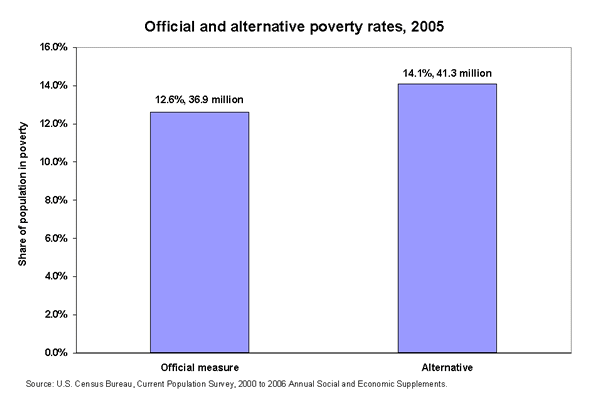See Snapshots archive.
Snapshot for April 11, 2007.
More poverty than meets the eye
When it comes to poverty in America, almost every analyst agrees that the official measure is terribly out-of-date and no longer provides a valid indication of economic deprivation. Thankfully, the Census Bureau has implemented the recommendations of a mid-1990s panel of social scientists devoted to correcting the shortcomings of the official measure.
The most accurate of these recommended new measures1 makes several improvements: it accounts for the costs and benefits of taxes and near-cash transfers, like food stamps; it reduces the income of working families for costs associated with work; it makes adjustments for price differences throughout the country; and, it allows the poverty thresholds to reflect changes in consumption by the non-poor.
Given the above improvements, the alternative threshold for a family with two parents and two children was $3,000 higher than the official threshold: $22,841 vs. $19,806.
Compared to the official measure, the more-accurate measure reflects a substantially higher rate of poverty in America. In 2005, 14.1% of Americans—41.3 million—were poor according to the alternative, compared to 12.6%—or 36.9 million—under the official measure (see Figure). In other words, the United States has over 4 million more people living in poverty than typically reflected in the traditional poverty rate statistics.

There are two important policy implications in this finding. First, we demonstrably have the methods and capacity to get a much more accurate read of poverty in America. We should put the official measure out of its misery and adopt this alternative as our official measure. Second, the stakes are too high to risk getting this wrong. Many safety-net programs are tied to official poverty status, and by erroneously excluding those in need from our measure, we fail to reach millions more who desperately need the help.
Note
1. The source for these data is http://www.census.gov/hhes/www/povmeas/altmeas05/nas_measures_historical.xls. I use the alternative definition labeled CMB-GA-CE, as this one seems to hone most closely to the panel’s recommendations. “CMB” refers to the combined method of accounting for health costs, “GA” means this measure includes geographical price adjustments, and CE means that this choice uses changes in actual consumption expenditure patterns to update the thresholds (other alternatives only use prices).
